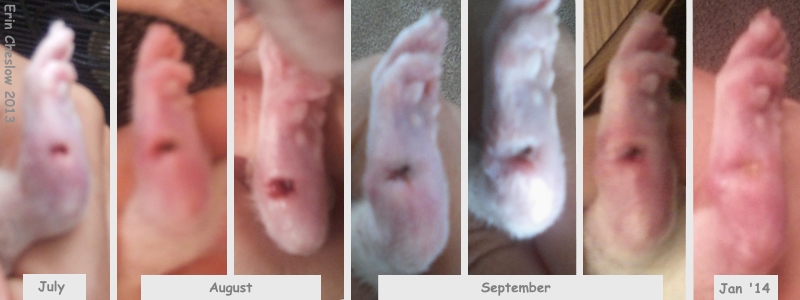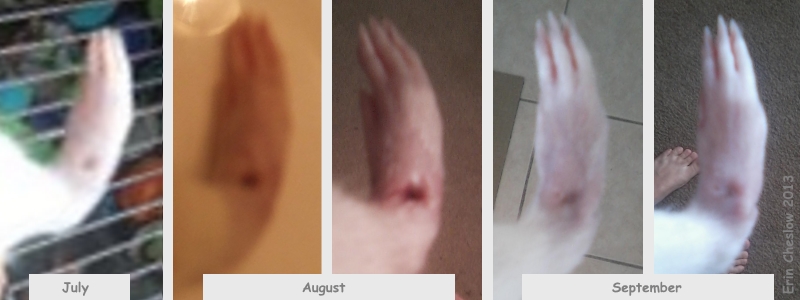Figure 1: Abrasion / puncture wound to hind foot in 18 month old female rat (Silky).
Case history and photos
History
Silky is a 1.5 year old intact female rat, weighing 362 grams, with no previous history of illness or injury.
Clinical Signs
On 7 June 2013 Silky sustains a small superficial scratch to the outer (lateral) side of the sole of her right hind foot, which quickly becomes an abscess. She is taken to the veterinarian within 24 hours of the abscess forming. At this point the right hind leg is severely swollen and warm to the touch, with areas of redness (erythema). Silky avoids placing weight on the leg. The veterinarian places Silky under brief gas anesthesia and incises and flushes the abscess with dilute Chlorhexidine. She prescribes a course of (oral) Baytril, as well as (oral) Metacam for a few days for pain and inflammation control. Silky is housed separately from her cagemates.
Following a week of the above treatment there does not appear to be much improvement. The foot is severely inflamed, with areas of purple, and very painful to the touch. Clavamox is added to the antibiotic treatment, as well as a stronger painkiller, Buprenex (both to be administered orally). The owner is also instructed to start soaking Silky’s right foot in an Epsom salt bath twice a day, for 15 minutes. In addition, after the soaks, Silky’s owner flushes the wounds using a syringe and saline solution.
A few days later the swelling of the foot has gone down slightly, though it is still severe and Silky is still not placing weight on the leg. Two additional wound openings have formed on the foot: one on the inner (medial) side of the sole, and one on top of the foot. Silky has also developed diarrhea. The veterinarian lightly debrides the scabs to allow for drainage; the discharge is green and malodorous.
Diagnosis
On 19 June the veterinarian inspects a swab of the green discharge under a microscope and suspects that Silky has a Pseudomonas infection in her right hind foot.
Note that the culture taken on 31 July reveals that it is in fact a meth-resistant Staphylococcus schleiferi (MRSS) infection that is sensitive to Rifampin, Linezolid, Moxifloxacin, Vancomycin and Tobramycin. Escherichia coli bacteria are also found.
Treatment
On 19 June the veterinarian changes Silky’s antibiotic treatment regimen to daily injections of Amikacin, with instructions to ensure that Silky has sufficient fluid intake (due to the antibiotic’s nephrotoxic side effects); this can be in the form of drinking water or Pedialyte or moisture in baby food. The Buprenex is also continued. (The Baytril, Clavamox, and Metacam are discontinued.)
The foot seems to heal nicely for about three weeks: there is no more redness; one of the openings has closed up completely and the other two are considerably reduced in size; the swelling is almost completely gone; less pus is observed every day; and Silky is able to use her foot again for scratching, walking and even climbing. The middle of the foot (tarsal joint), however, is still inflexible, and Silky has lost some weight: she now weighs 320g. In the fourth week on Amikacin the progress slows down, although the wound openings do seem to continue reducing in size and appear to be draining well.
On 17 July the veterinarian decides to cease the antibiotic treatment for a few days, to rest Silky’s kidneys.
After four days the two wound openings seem to have increased slightly in size, as does the swelling of the foot, and there appears to be more pus. Silky is still walking on her right foot, though there is a slight limp on uneven surfaces. She is still active and eating and drinking normally. Silky’s owner adds a probiotic (Benebac) to the treatment regimen.
A week later one of the wounds appears black underneath the skin. The (thin) skin is peeled off by Silky’s owner and hard white material is removed from the wound. As Silky squeaks every time her foot is touched, she is given a dose of Metacam for the pain. Over the next few days, the wound appears deeper than before.
On 31 July, two weeks since ceasing the antibiotic treatment and almost eight weeks after the initial scratch to the foot was sustained, Silky is taken back to the veterinarian. There is some swelling around the scabs and they are painful when touched. A culture is taken from the wound on the sole of the foot. The Amikacin injections are restarted.
A week later there is a slight set-back when Silky accidentally escapes from her cage and spends most of the day walking on the cage bars. When her owner returns home Silky’s foot has swollen considerably and there is drainage of pus and blood. Silky is put on Metacam for a few days. The swelling quickly decreases over the course of the week.
Note that Silky has started gaining weight again: she now weighs 340g.
On 14 August the results of the culture come back: MRSS (see Diagnosis section). The veterinarian decides to continue the treatment regimen of Amikacin injections.
However, on 20 August the swelling in Silky’s foot increases again. Considering the possibility of bacterial resistance and that the infection may have spread to the bone (osteomyelitis), the veterinarian decides to change the antibiotic treatment regimen to twice daily (oral) Clindamycin. If this does not have a positive effect, X-rays will be taken to check for a bone infection and amputation of Silky’s right hind foot may need to be considered. However, although rats cope well on three limbs, this is considered to be a last resort by both the veterinarian and owner.
Outcome
By 30 August, after two weeks on the Clindamycin, the swelling of the foot has decreased considerably. The wounds still drain, though not every day. The treatment is continued. Silky has not developed diarrhea or even a loose stool due to the Clindamycin.
In early September the wound on top of Silky’s foot has healed. On 18 September there is a slight set-back when blood pools under the skin. Silky’s owner opens the wound up slightly and it drains a lot. Silky is given a dose of Metacam. By the end of September Silky’s foot is still continuing to heal. There is little to no swelling or inflammation anymore.
In early October the wounds are just superficial scabs and the Epsom salt soaks are ceased. Silky is slowly reintroduced to her cagemate. By mid-October Silky’s foot has mostly healed and is no longer draining. It has, however, atrophied, causing Silky to be a bit off balance sometimes. In October, after eight weeks on the final treatment regimen, the Clindamycin is ceased. It has been a little over four months since the initial scratch to the foot was sustained.
Photos
|
|
 Row 2: This row shows the healing process of the wound on the sole of Silky’s right hind foot. The first photograph was taken on 29 July 2013 and clearly shows the swelling of the foot. The second and third photographs were taken on 9 and 14 August, during the (restarted) Amikacin treatment. The following three photographs were taken on 13, 17 and 18 September, during the Clindamycin treatment. Note the apparent increase in swelling on 18 September, when blood pooled under the skin and the wound had to be opened up and drained. The final photograph was taken on 10 January 2014; the wound on the sole of the foot has now healed. Note the clearly visible curling under of the rightmost toe. |
Case history and photos courtesy of Erin Cheslow.



